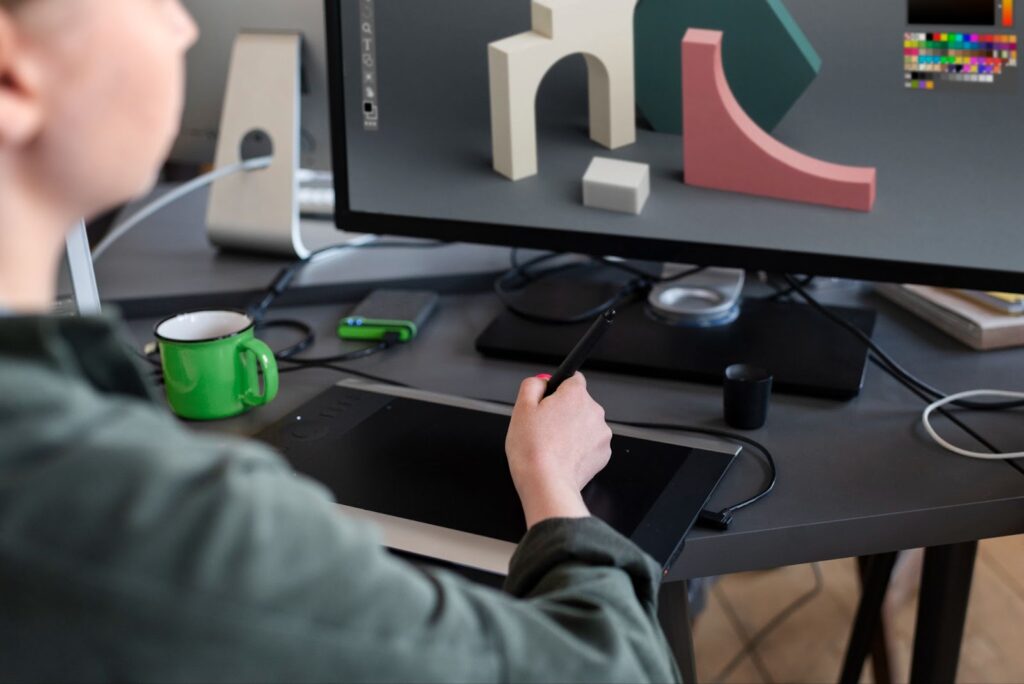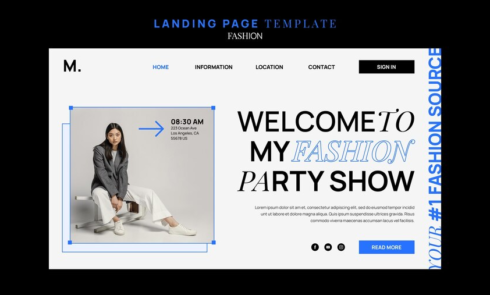Figma presents a seamless avenue for swiftly crafting static designs and prototypes, yet its capability may appear somewhat limited when endeavoring to flesh out concepts enriched with intricate animations. The challenge lies in conveying transitions effectively to developers through a two-dimensional prototype, which can sometimes lead to a disconnect in conveying ideas comprehensively to clients, as they must rely on descriptions rather than firsthand experience.
As fervent proponents of Figma and avid users ourselves within the realm of web creation sans coding, we embarked on a mission to streamline the process. Our brainchild, a bespoke Figma plugin, revolutionizes the transformation of static designs into dynamic, fully animated web interfaces with remarkable ease. The beauty of our solution lies in its simplicity – animating your Figma creations requires no coding prowess whatsoever. Let’s delve deeper into the mechanics behind this innovation.
Exploring the Creative Process: Bringing Figma Designs to Life with Animation
Are you ready to elevate your Figma designs to the next level? Dive into the fascinating world of animation with our step-by-step guide. Uncover the secrets to seamlessly integrating hover animations into your Figma designs using Vev. Let’s embark on this creative journey together and unleash the full potential of your designs.
Step 1: Craft Your Vision in Figma
In this tutorial, we’ll embark on a journey into the realm of artificial intelligence-inspired design. Delve into the captivating possibilities of AI-driven artwork and discover how to infuse your designs with cutting-edge flair. Before diving into animation, let’s lay the groundwork by crafting our design in Figma.
- Explore AI Artistry:
- Experiment with DALL-E: Harness the power of AI to generate captivating artwork. Dive into platforms like DALL-E by OpenAI to explore limitless creative possibilities;
- Free or Sample Art: Utilize the free generation options provided by DALL-E or download sample art to kickstart your design process.
- Layout Design:
- Organize Sections: Divide your design into distinct sections, each representing a unique aspect of your concept;
- Artboard Structure: Optimize your Figma file by creating separate artboards for each section, ensuring clarity and ease of translation into Vev.
- Style and Composition:
- Expressive Designs: Infuse your designs with personality and flair. Experiment with different styles and compositions to evoke the desired emotions;
- Visual Cohesion: Maintain consistency across sections while exploring diverse design elements. Strike a balance between creativity and coherence.
Step 2: Seamless Integration of Your Design into Vev Platform
After putting the final touches on your design masterpiece within Figma, the next thrilling phase awaits – importing it into Vev. This step bridges the gap between your static design and dynamic web animation, bringing your creation to life effortlessly. Here’s how to seamlessly transition your design from Figma to Vev:
- Prepare Your Design: Ensure your Figma design is polished and reflects your vision accurately. Double-check alignment, spacing, and overall aesthetics to guarantee a smooth transition;
- Initiate the Import: With your design finalized, initiate the import process by utilizing the Vev plugin integrated within Figma. This intuitive plugin acts as a conduit, effortlessly transferring your design into the Vev platform;
- Select Your Main Artboard: Choose the primary artboard representing your design’s core structure. This serves as the foundation for the subsequent import process;
- Activate the Plugin: Run the Vev plugin from within Figma, signaling the initiation of the import process. A dialog box promptly appears, guiding you through the necessary steps;
- Confirm Asset Import: Review the assets to be imported into Vev within the dialog box. Ensure all essential elements are included for a seamless transition;
- Input Figma File URL: In the dialogue box, provide the URL of your Figma file. This establishes the connection between your Figma design and the Vev platform;
- Initiate Import: Upon pasting the Figma file URL, a new tab opens in your browser, showcasing the imported project within Vev. Witness your design seamlessly translated into a dynamic web canvas, ready for further enhancements;
- Explore Vev’s Interface: Familiarize yourself with Vev’s intuitive interface, where you’ll orchestrate captivating animations and interactivity. Navigate through the canvas and acquaint yourself with the plethora of tools and features at your disposal;
- Unleash Your Creativity: With your design imported and the Vev platform at your fingertips, embark on a journey of creativity. Experiment with animations, transitions, and interactions to elevate your design to new heights;
- Preview and Iterate: Continuously preview your work to assess its functionality and visual appeal. Iterate as needed, refining your design until it perfectly aligns with your vision;
- Prepare for Publishing: As you fine-tune your design within Vev, keep the end goal in mind – publishing your creation for the world to see. Ensure compatibility across devices and browsers, optimizing performance and user experience.
Step 3: Enhancing Interactivity: Adding Dynamic Animations to Figma Designs in Vev
Animating your Figma designs in Vev can inject life and interactivity into your creations, elevating them from static to engaging experiences. Let’s delve into the steps to introduce captivating animations to your designs, bringing them to life with ease.
1: Add Hover Animations
The first step towards injecting interactivity into your designs is to incorporate hover animations. Here’s how you can do it:
- Select Your Element: Choose the element you want to animate upon hover. It could be an image, icon, or any other design element;
- Access Animation Addons: Navigate to the “Addons” menu located in the top right corner of the interface. Select the “Animation” addon to proceed;
- Choose Hover Animation: Opt for a “Hover animation” to trigger the desired effect when a user hovers over the element;
- Customize Animation: Select the type of animation you prefer. For instance, you can apply scale and rotation animation to make the element increase in size and gently rotate upon hover;
- Adjust Settings: Fine-tune the duration and delays of the animation to ensure optimal visibility and impact when a user interacts with the design.
Pro Tips:
- Create presets of animations to streamline the process and maintain consistency across your design;
- Experiment with various scale and rotation values to add unique flair and variation to each animated element.
2: Add Scroll Animations
Take your design to the next level by incorporating scroll animations. Here’s how you can do it:
- Identify Elements for Animation: Determine which elements you want to animate as the user scrolls through the page;
- Choose Animation Effects: Select the desired animation effects to apply. For instance, you can make elements appear or change opacity as the user scrolls;
- Apply Scroll Animations: Utilize scroll animations to add dynamic effects to your design. For example, you can make a spotlight appear to “turn on” as the user scrolls into a section;
- Customize Behavior: Fine-tune the animation settings to achieve the desired behavior. Adjust parameters such as opacity, speed, and direction to create seamless and immersive scrolling experiences.
Pro Tips:
- Experiment with parallax scrolling effects to create depth and dimensionality in your design;
- Combine scroll animations with hover effects for a multi-dimensional and interactive user experience.
Introducing Cursor Parallax Animation: Elevating Your Artwork Interaction
When it comes to showcasing artwork on your website, captivating interactions can truly make your pieces stand out. Imagine adding a dynamic dimension to your art, where it responds to the user’s cursor movements in a mesmerizing dance. With Vev’s array of pre-built interactions, implementing this feature becomes a breeze.
- Selecting the Artwork: Start by choosing the artwork you want to enhance with cursor parallax animation. This could be a striking painting, an intricate illustration, or a captivating photograph;
- Applying the Addon: Navigate to the interaction options and select the “Mouse Move Parallax” addon. This feature eliminates the need for tedious manual coding, saving you valuable time and effort;
- Fine-tuning the Movement: Adjust the movement factor to your liking. Lower values ensure subtle, nuanced movements, while higher values create more pronounced responses to cursor placement;
- Directional Movement: Decide whether you want the element to move towards or against the cursor. For an immersive experience that brings the user closer to your art, opt to move the element towards the cursor as they explore the page;
- Dynamic Interaction: Watch as your artwork comes to life, gracefully following the user’s cursor movements. This interactive element adds depth and engagement, inviting visitors to interact with your content in a playful and immersive manner.
By incorporating cursor parallax animation, you not only showcase your artwork in a unique light but also create a memorable user experience that leaves a lasting impression.
Enhancing Artwork Visibility with Skewed Hover Animation
In the realm of web design, every detail matters, especially when it comes to presenting a collection of artworks in a visually appealing manner. With Vev’s animation addons, you can effortlessly elevate the visibility of your art pieces with a captivating skewed hover animation.
- Creating Depth on Hover: Start by selecting the elements you want to animate upon hover. Whether it’s a gallery of paintings, photographs, or digital illustrations, each piece can now come to life as users interact with them;
- Adding Animation Addon: Choose the animation addon option and configure it to trigger upon hover. This simple yet effective feature allows you to enhance user engagement by offering a dynamic viewing experience;
- Skewing Effect: Implement the skewed effect by adjusting the scaling and horizontal positioning of the elements upon hover. This subtle transformation provides users with a closer look at the details of each artwork, encouraging exploration and discovery;
- Streamlined Workflow: Save time and effort by creating a shared preset for your animation effects. With just a few clicks, you can apply the same animation settings to multiple elements, ensuring consistency and coherence across your design;
- Isometric Animation: Take your animations to the next level with the isometric addon, which allows you to animate elements into an isometric view. Customize the values to achieve the desired aesthetic and directionality for each element.
Step 4: Fine-tune Your Design for Different Devices
As you near the completion of your design journey, it’s crucial to ensure your creation looks impeccable across various devices. Making your design responsive is key to its success. Embrace the flexibility of Figma by utilizing the breakpoint selector located conveniently in the bottom-left corner. This feature empowers you to adapt your design effortlessly for different screen sizes, ensuring a seamless user experience across desktops, tablets, and mobile devices.

Here’s how you can optimize your design for each device:
- Desktop View:
- Prioritize spacious layouts that utilize the wider screen real estate effectively;
- Ensure all elements are appropriately sized and spaced for comfortable viewing;
- Test interactive features to ensure they function smoothly without overwhelming the user.
- Tablet View:
- Simplify the layout to accommodate the narrower width of tablet screens;
- Consider rearranging elements to maintain visual hierarchy and readability;
- Opt for touch-friendly controls and navigation for a user-friendly experience.
- Mobile View:
- Streamline the design further to fit the limited screen space of mobile devices;
- Resize and reposition elements to eliminate clutter and enhance usability;
- Pay close attention to font sizes and touch targets to enhance accessibility.
By fine-tuning your design across devices, you guarantee that your creation resonates with users regardless of the platform they choose to engage with it. This adaptability not only enhances user satisfaction but also boosts the credibility and professionalism of your work.
And there you have it! With your design polished and optimized for various devices, you’re ready to embark on the next phase of your creative journey. Whether you’re embedding your design into existing projects or exploring hosting options like Vev, the possibilities for sharing your interactive masterpiece are endless. Let your creativity shine as you unleash your animated Figma design onto the digital landscape.
Conclusion
In conclusion, our Figma plugin represents a pivotal advancement in bridging the gap between static design and dynamic web interfaces. By seamlessly integrating animation capabilities into the Figma workflow without the need for coding, we empower designers to breathe life into their creations effortlessly. With our plugin, the journey from concept to interactive prototype becomes not only smoother but also more immersive, ensuring clearer communication with both developers and clients. Embracing the spirit of innovation, we continue to pioneer solutions that enhance the creative process and elevate the standard of digital design.

